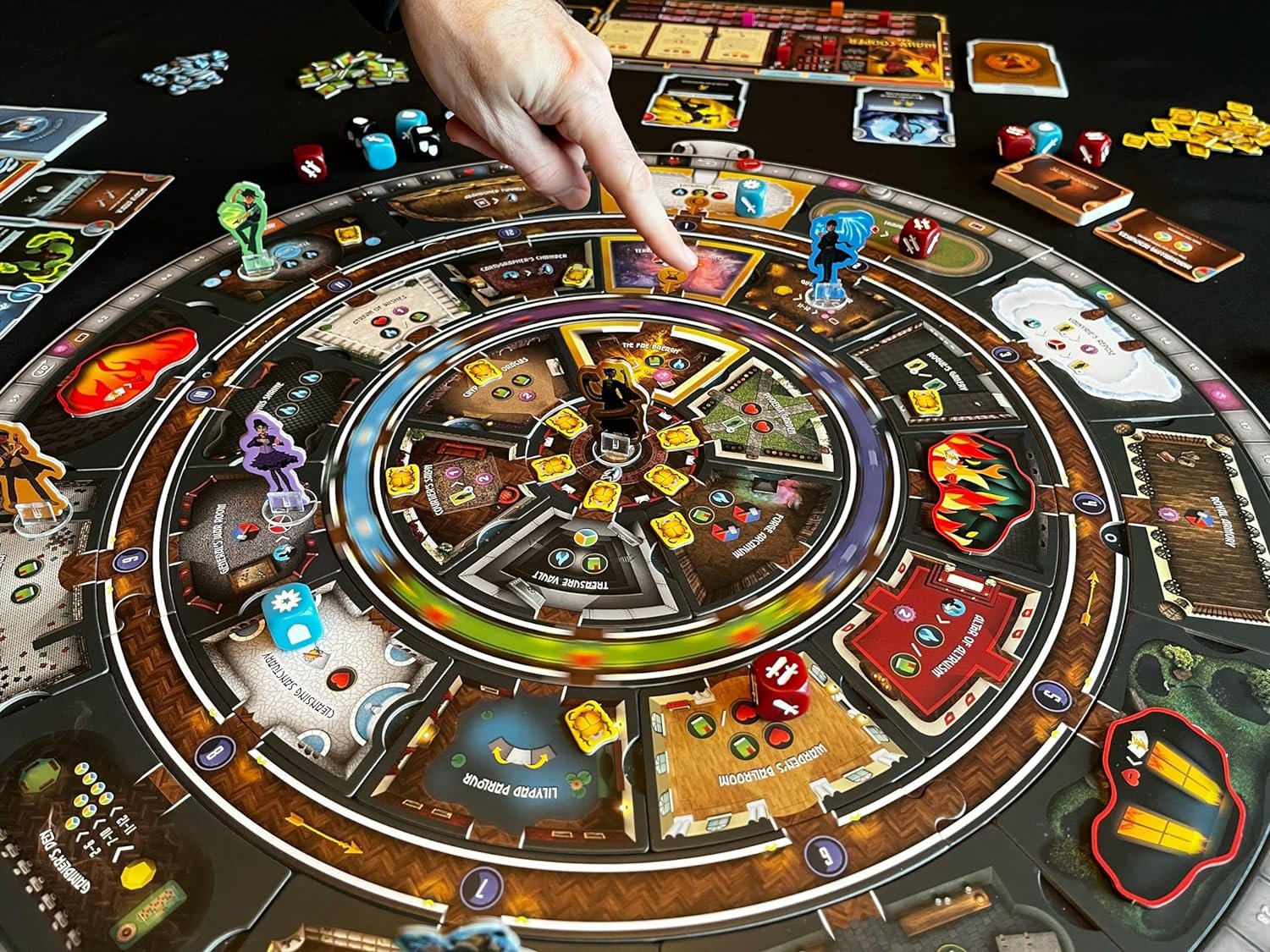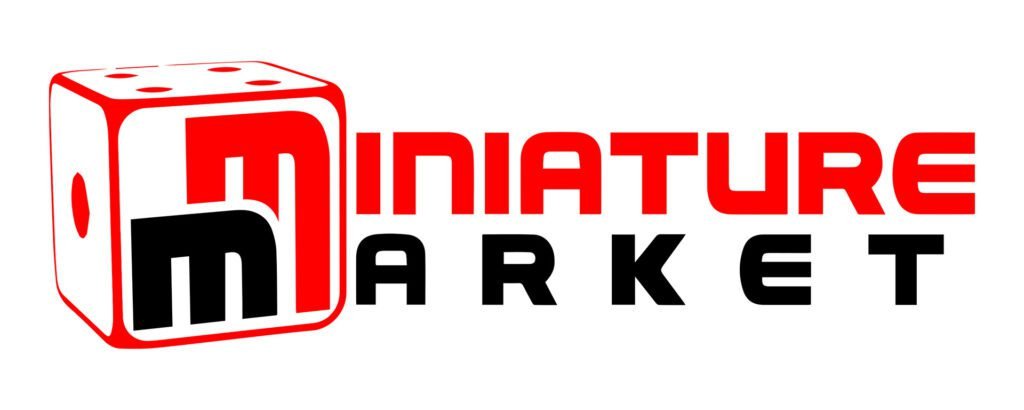
Today we’re diving into Weirdwood Manor. This is a cooperative board game with a whimsical, slightly spooky theme, based on a young adult book series. So, let’s break it down—what it is, what’s good, what’s bad, & if you should pick it up. Let’s get into it.

What It Is
Weirdwood Manor is a cooperative board game where players team up to save Lady Weirdwood & her magical mansion from various supernatural threats. It features a dynamic rotating board that represents the ever-changing layout of the manor, making movement & planning unpredictable. Designed for 1-5 players, the game combines card play, resource management, & strategic coordination to overcome obstacles & defeat monsters.
Each player takes control of a unique character with their own special abilities, & together, they must navigate the shifting rooms, manage resources, & complete objectives to win. There are three different monsters to choose from, each offering a unique challenge, & the ever-changing manor adds a dynamic layer of complexity to the gameplay.
Check Out These Recent Board Game Sales
- Board Game Sale: Disney Villainous 25% Off!
- Board Game Sale: Marvel: Crisis Protocol Core Set 30% Off!
- Board Game Sale: 7 Wonders Available for 17% Off!
Gameplay Overview
In Weirdwood Manor, players assume the roles of one of six unique wardens, each possessing distinct abilities & a personal deck of 13 action cards. The goal of the game is to navigate the mysterious rooms of the manor, collect valuable resources, strengthen their characters, recruit companions, & ultimately battle Clockwork Scarabs. The final objective is to rescue Lady Weirdwood & defeat the main monster before time runs out.
The game board features a circular manor with three rings of rooms surrounding a central throne room. Time management plays a key role, as two concentric rings—one tracking the time of day & the other the passing days—advance with each action. Players must defeat the monster by the end of the 12th day or face defeat.
Each player’s turn begins by selecting an action card from their hand & playing it to one of the available slots on their player board. This triggers the advancement of time on the rings & the performance of actions outlined on the card. Common actions include moving between rooms, engaging in combat, collecting resources, & utilizing room-specific abilities to gain an edge.
Movement within the manor is dictated by the arrangement of rooms & the positions of the time rings, which act as dynamic hallways. Players can move freely as long as they reach a different room & can chart a path. However, obstacles like scarabs, monsters, fire, & rubble may hinder progress or inflict damage, forcing players to plan their movements carefully.
Combat is resolved using dice rolls based on each player’s attack & defense stats. Players can forge additional dice throughout the game by spending resources, giving them an edge in future battles. The game features three types of dice: balanced blue dice, defensive black dice, & offensive red dice, allowing players to tailor their combat strategy.
Companions play a pivotal role in Weirdwood Manor, offering extra action slots & unique abilities. They can be used by exhausting their abilities, & are refreshed when all player action slots are full & cleared. Players can also play tactic cards, which grant temporary boosts, alongside their action cards for further advantages.
Resource management is critical for success. Players collect tokens representing knowledge, magic (min), & scarabs they’ve defeated, all of which are used to power abilities, forge dice, & recruit companions. Additionally, power tokens are reserved for specific uses, adding an extra layer of strategy to resource allocation.
A Scarab phase occurs when a player’s action slots are filled, during which the scarabs move through the manor & may blight rooms, rendering them unusable until cleared. Managing the scarab threat is essential to avoid losing access to key resources or abilities, adding another layer of tension to the gameplay.

The Components
The production values in Weirdwood Manor are top-tier. The artwork is colorful & slightly spooky, reminiscent of classic monster cartoons from the 70s, adding to the game’s charm. The rotating board is well-designed, & despite the complexity of its mechanics, the physical components hold up well under frequent use.
The miniatures & tokens are also of high quality, making the game feel immersive from the moment you open the box. The cards & other elements are sturdy & detailed, ensuring longevity even with multiple plays. Every aspect of the game’s production enhances the quirky, magical atmosphere of the Weirdwood world.
The Good
One of the best parts about Weirdwood Manor is its immersive theme. From the rotating board to the character abilities, everything ties into the magical, ever-changing nature of the manor. The game’s mechanics feel natural to the setting, & it’s easy to lose yourself in the experience, even if you’re unfamiliar with the book series it’s based on. The artwork & components all contribute to creating a vibrant world that’s fun to explore.
Another strong point is the game’s depth & replayability. The variety of characters & monsters ensures that no two games feel alike. Players are encouraged to experiment with different combinations of characters & strategies, giving the game a long lifespan. The rotating board mechanic adds another layer of unpredictability, making each game session feel fresh & challenging.
The Bad
However, the game is not without its flaws. The complexity of Weirdwood Manor can be overwhelming, particularly for new players. While the rotating board is a fun & innovative mechanic, it also makes planning ahead extremely difficult. This, combined with a rulebook that can be tricky to navigate, can lead to frequent stops in gameplay to clarify rules or actions, disrupting the flow of the game.
Another drawback is the game’s length. Sessions often run longer than expected, especially at higher player counts. This extended playtime can lead to frustration if players feel stuck or unable to make meaningful progress due to the shifting board & unpredictable actions of the monsters. The game’s complexity & length might deter casual players, making it feel like a commitment rather than a breezy, cooperative experience.
The Verdict
So, should you buy Weirdwood Manor? If you’re a fan of immersive cooperative games & enjoy exploring deep, strategic mechanics, this game is absolutely worth your time. The rotating board & unique character abilities create a fresh experience with each playthrough, & the game’s production values add to its appeal. It’s a game that rewards repeat plays, offering new challenges every time you come back to it.
That said, if you prefer lighter, quicker games or get frustrated by unpredictable mechanics & long sessions, this may not be the best fit. Weirdwood Manor is demanding in both time & mental energy, & while it offers a rich experience, it’s not for everyone. If you’re up for a more complex, thinky game with a steep learning curve, you’ll find a lot to love here.

Final Thoughts
Wrapping up my thoughts on Weirdwood Manor, I’m left feeling a bit torn. On one hand, the theme & presentation are top-notch. It’s got this unique vibe that immediately draws you in, whether or not you’re familiar with the world it’s based on. The attention to detail in the art & components really helps immerse you, & I can see why that alone would make it appealing to a lot of players. It’s definitely not a cookie-cutter game, & that’s always something I appreciate. There’s this quirky charm to it that’s hard to deny.
That said, once you dive into the actual gameplay, things start to get a little messy. For me, the mechanics didn’t flow as smoothly as I’d hoped. There were just too many moments where I felt stuck, both literally in the game with blocked-off rooms, & figuratively, trying to keep track of all the moving parts. It’s a game that demands a lot of attention to detail, & sometimes it felt like I was doing more admin work than actually playing. Especially in a co-op game, I want to feel like every turn matters, but here, there were too many times where it felt like I was spinning my wheels.
One of the bigger issues for me was the way the game could drag on. Don’t get me wrong, I’m not opposed to longer games, but it needs to feel like the time is well spent. Here, it often felt like things were taking longer than necessary, especially with how much back-and-forth there was with the rulebook. & as much as I like the concept of the shifting rooms, it can sometimes work against you, leaving you with a sense of wasted turns. It’s like the game is just a little too clever for its own good.
Now, on the positive side, I do think the more you play, the more you can see the strategy behind it. Once I got into the rhythm, especially in a two-player game, I found myself appreciating the puzzle-like aspects. There’s a lot of depth here if you’re willing to dig into it, & I imagine some players will really enjoy that challenge. It’s the kind of game that rewards repeat playthroughs because you get better at working within its limitations. Still, for me, the experience felt a bit uneven, & I couldn’t shake the feeling that it needed more refinement.
Ultimately, I think this game has a lot of potential, but it’s not quite there yet. I’d love to see a second edition with some tweaks—fewer rooms, more streamlined mechanics, & maybe just a bit more player agency. There’s a solid foundation here, & I believe with the right adjustments, it could really shine. But as it stands now, it’s a game I enjoyed more in theory than in practice.
So, while I had fun with certain aspects of it, I can’t say it fully won me over. If you’re into heavy thematic games with a bit of a puzzle element, it’s worth giving a try, but go in knowing it has some rough edges. For me, it’s one of those games I like but don’t love—there’s something special here, but it’s not quite hitting its full potential yet.
Purchase Options


At no extra cost to you, The Board Game Site may receive revenue from affiliate and advertising partnerships for sharing this content and from purchases through links.








